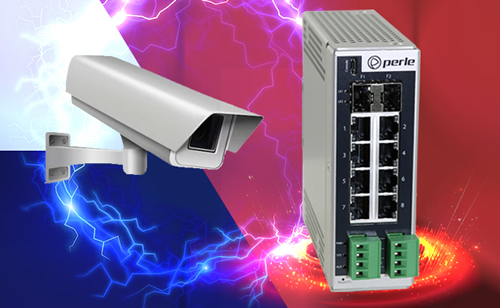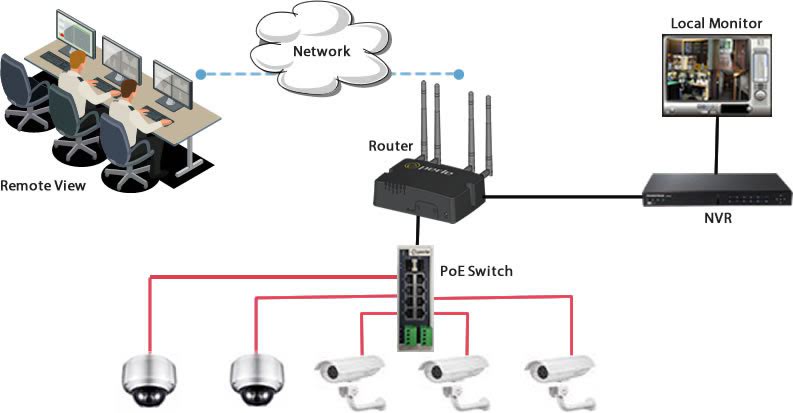
Selecting a PoE Switch for Video Camera Surveillance Systems
By Julie McDanielVice President Marketing
February 2, 2024
When setting up your security camera network, dealing with cable complexity can be a significant challenge. Thankfully, using PoE switches for security camera systems has become increasingly common. These switches simplify cabling by combining power and data transmission over a single Ethernet cable. With the wide variety of surveillance camera systems available, it is essential to understand how to choose the most suitable PoE switch for your specific requirements. In this article, we will explore the key considerations and factors to help you make an informed decision.
What is a PoE Network Switch?
PoE stands for Power Over Ethernet, a technology that enables devices to transmit power and data through the same cable. PoE switches enable connected devices to receive power and transmit data by utilizing a single Category 5, 6, 7, or 8 cable, simplifying installation processes and reducing costs associated with additional cabling requirements. If you're setting up multiple cameras, you can use the Ethernet cable to transmit power and data instead of running separate power and data cables to each camera.
Why is a PoE Switch Used for Security Cameras?
A PoE switch facilitates the interconnection between cameras and a Network Video Recorder (NVR) while transmitting video and audio data for recording. Using PoE switches allows for greater flexibility regarding camera placement. You no longer have to worry about whether there is a power source nearby, and you can place your cameras further away from the switch than you would be able to with separate power and data cables. PoE switches also have built-in safety features that can help to protect your surveillance system from damage. For example, if your cable has a problem, the switch will automatically shut off power to the affected device to prevent damage.
The utilization of PoE switches in surveillance camera systems is driven by their cost-effectiveness and support for high-resolution cameras, resulting in improved video quality.
Benefits of Using a PoE Switch for Security Camera Systems:
- Simplified Installation and Reduced Costs: Integrating power and data transmission through a single cable streamlines the installation process and significantly reduces the need for additional cabling. This not only saves time and effort but also minimizes overall costs.
- Longer runs: PoE network switches can transmit data and video signals over significant distances, making them ideal for extensive installations. This eliminates the need for additional equipment or complex configurations to transmit signals over long cable runs.
- Greater Flexibility and Expandability: PoE network switches are highly scalable, allowing your video surveillance system to expand quickly. With the ability to connect multiple cameras and recording devices, PoE switches are well-suited for small-scale installations and large-scale surveillance systems.
- Larger power output: PoE switches with sufficient power capacity can provide ample power to cameras, eliminating issues like video loss and performance degradation.
- Easier management: The activity lights on the switch enable troubleshooting and monitoring of cameras, enhancing system management and maintenance.
Understanding IEEE PoE standards:
It's important to note that some PoE switches use proprietary protocols that can cause compatibility issues with the devices of other vendors on the network. When choosing a PoE Switch, it's advisable to only go for ones that comply with the industry standards set by IEEE, specifically 802.3af, 802.3at, and 802.3bt. By doing so, you can ensure that your equipment is not damaged and that it will be interoperable with the products from other vendors. However, choosing a PoE switch compliant with an older standard may result in the need to replace it in the future. With IEEE 802.3bt being fully backward compatible with the older standards, choosing a compliant switch will eliminate the need to replace it as cameras get updated. Therefore, selecting both your cameras and PoE switches that fully adhere to these standards, specifically an 802.3bt-compliant switch to support present and future requirements is highly recommended. Read our article about choosing the right power sourcing equipment for more in-depth information.
What are the Different Types of PoE Switches?
Standard PoE Switches are 802.3af compliant, can provide up to 15.4 watts of power per port, and are suitable for most security cameras.
PoE+ Switches are 802.3af compliant, provide up to 30 watts of power per port, and are suitable for powering larger or higher-resolution cameras.
High-Power PoE Switches are 802.3bt compliant, provide up to 90 watts per port, and are suitable for powering pan-tilt-zoom (PTZ) security cameras with heaters.
Other Factors to Consider When Choosing a PoE Switch for Surveillance Camera Systems:
- Port Count: PoE switches come in various sizes. Assess the number of cameras in your system and choose a switch with adequate ports. Also, consider the power consumption of your cameras to avoid overloading the switch.
- Power Supply Voltage: Verify your cameras' power requirements (12V or 24V) to ensure compatibility and prevent damage due to incorrect voltage supply. If your camera specifies "INPUT 12V / PoE", the device can be powered by a 12 VDC wall adapter OR a PoE Ethernet port. If you don't have an electrical wall outlet nearby, you need a 48V PoE Switch compliant with the IEEE 802.3bt/af/at standard to provide power to these devices.
- Power Budget: Evaluate the maximum power supply capability of the PoE switch and compare it to your camera's power requirements. Ensure that the switch can deliver sufficient power to each port by calculating the maximum available power per port by using this formula: Maximum per Port Power Average = (Switch Maximum Power Consumption - Switch System Power) / Number of PoE Ports.
- Maximal Power Supply: Confirm that the PoE switch's maximum power supply aligns with your cameras' power demands, especially pan-tilt-zoom (PTZ) cameras. The more power you have, the more you can deliver per port. Therefore, choosing a PSE that can provide a total higher Wattage protects against video loss and poor performance, reducing your chances of needing an upgrade later.
- Bandwidth Capacity: Consider the bandwidth requirements of your cameras and choose a PoE switch with the appropriate capacity (Fast Ethernet for 100Mbps or Gigabit for 1000Mbps).
- Unmanaged or Managed PoE Switch: Determine whether an unmanaged or managed PoE switch suits your needs. An unmanaged switch provides a simple plug-and-play solution for small-scale applications, while a managed switch allows for greater customization, monitoring, remote control, and configuration of networking protocols and features such as VLANs, IGMP Snooping, QoS, and more
- Industrial PoE Switches: Consider using industrial PoE switches to withstand extreme temperatures, vibrations, and shocks in outdoor or harsh environments.
How to Connect Security Cameras to a PoE Switch:

- Connect the router to the PoE switch's LAN port using an Ethernet cable.
- Connect the PoE switch to a power outlet or surge protector using a power cable.
- Connect your cameras to the PoE switch's ports using Ethernet cables.
- Add the cameras to the NVR for viewing and recording.
- Connect the router to the Internet if remote access is required.
Conclusion:
Selecting the right PoE switch for your surveillance camera system is crucial for achieving optimal performance, scalability, and reliability. By considering factors such as port numbers, power supply voltage, power budget, maximal power supply, bandwidth capacity, and the need for managed or unmanaged switches, you can make an informed decision that meets your specific requirements.



